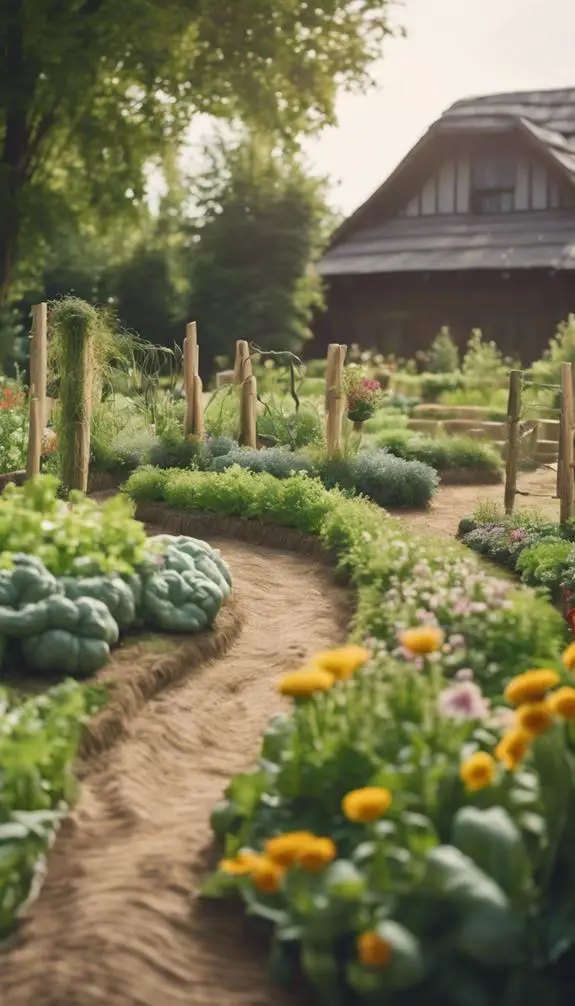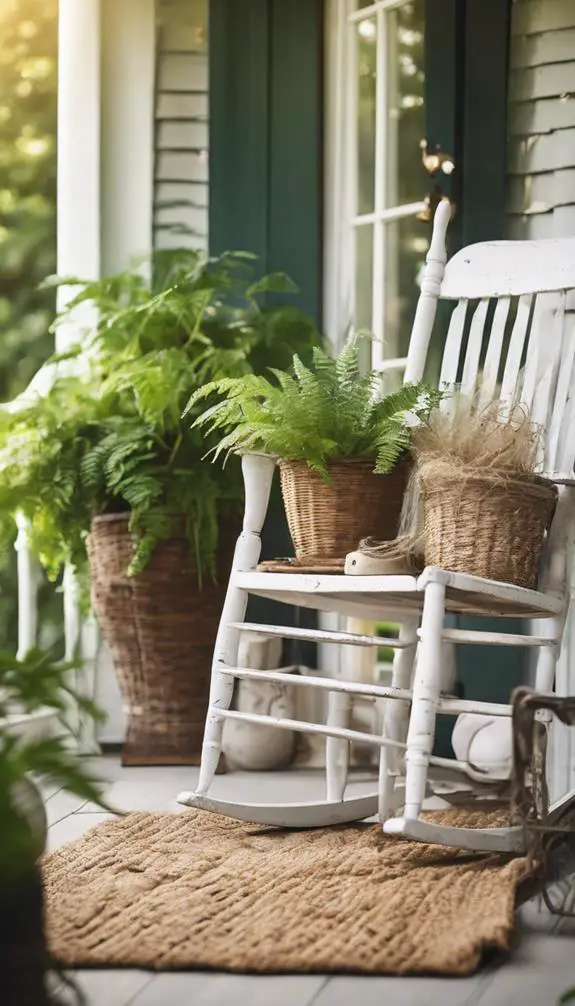As you prepare to plant your tomatoes, you're likely wondering what it takes to grow a bountiful harvest. You've probably heard that choosing the right variety is vital, but did you know that soil preparation is equally important? By testing your soil's pH level and nutrient content, you'll be able to provide your tomatoes with the ideal environment to thrive. But that's just the beginning – there are several more critical steps to take to guarantee your tomatoes get off to a strong start.
Summary
- Select strong tomato varieties resistant to common diseases and pests, considering growth habit, days to maturity, and climate adaptability.
- Prepare soil by testing pH levels, adding organic matter like compost, and mixing it into the top 6-8 inches for improved structure and fertility.
- Plant tomatoes deeply, spacing them 18-24 inches apart, and providing support systems like cages or trellises to keep them upright and encourage even fruiting.
- Ensure tomatoes receive direct sunlight for at least six hours a day, with morning sun ideal, and water them slowly and thoroughly to provide about 1-2 inches of moisture per week.
- Wait until the last frost date has passed before planting, and consider the specific variety's needs, such as warmer or cooler climates, to give tomatoes the best possible start.
Choose the Right Tomato Variety

With hundreds of tomato varieties to choose from, selecting the right one can be overwhelming.
You'll want to ponder your tomato preferences, such as size, shape, color, and taste. Do you prefer sweet and tangy or acidic and bold?
Are you looking for a compact variety for small spaces or a vining type for trellises?
Variety characteristics like growth habit, days to maturity, and disease resistance also play a vital role.
Ponder the climate and region you're in, as some varieties thrive in hot and humid conditions while others excel in cooler temperatures.
Prepare the Soil for Planting
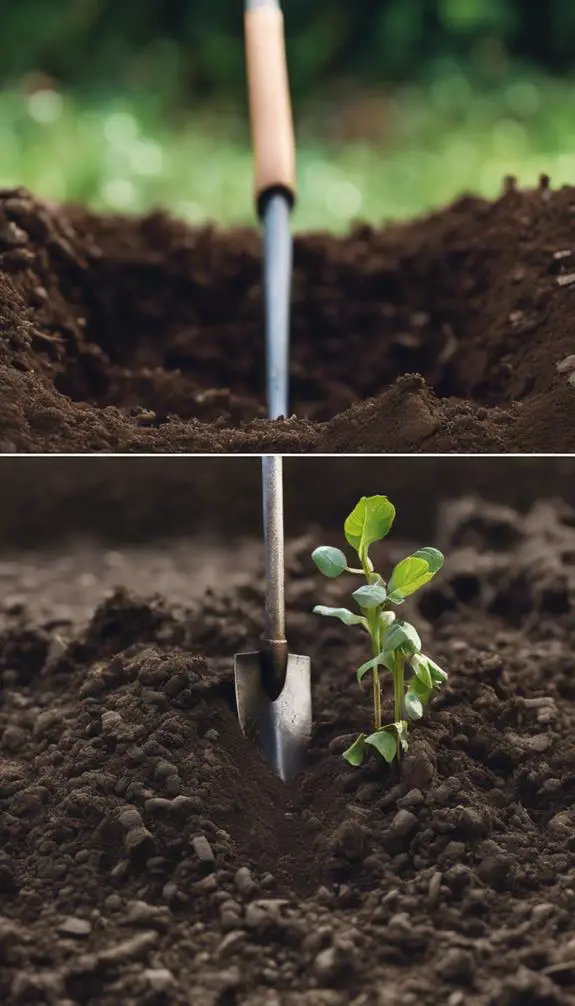
You've chosen the perfect tomato variety for your garden, now it's time to get your soil ready for planting.
Before you start, crucially, test your soil to determine its pH level and nutrient content. Soil testing will help you identify any deficiencies and take corrective action.
Add organic matter like compost to improve soil structure and fertility. Compost benefits include increased water retention, aeration, and microbial activity, creating a healthy environment for your tomatoes to thrive.
Mix 2-3 inches of compost into the top 6-8 inches of soil, and you'll be ready to plant. By preparing your soil properly, you'll set your tomatoes up for success and enjoy a bountiful harvest.
Start With Healthy Seedlings

You'll want to start with healthy seedlings that will give your tomatoes the best chance to thrive.
Begin by selecting strong varieties that are resistant to common tomato diseases and pests.
Next, inspect the seedling roots to verify they're well-developed and not pot-bound, and prepare a soil bed that's specifically tailored to their needs.
Choose Strong Varieties
Five top-performing tomato varieties can make all the difference in a successful harvest.
You'll want to choose varieties that have a strong disease resistance, as this will help prevent common tomato diseases like verticillium and fusarium wilt.
Consider varieties like 'Brandywine' or 'Cherokee Purple', which have a rich tomato history and are known for their robust flavor and texture.
Look for varieties that have been bred with disease resistance in mind, such as 'Patio' or 'Tiny Tim', which are perfect for small gardens.
Inspect Seedling Roots
With your strong tomato varieties chosen, it's time to turn your attention to the seedlings themselves.
Now, inspect the roots of your seedlings to verify they're healthy and ready for transplanting. Gently remove the seedling from its container, taking care not to disturb the roots.
Check for signs of root bound, where the roots have grown in a circular pattern, indicating they've outgrown the container. Also, look for root damage, which can hinder the seedling's ability to absorb water and nutrients.
If you find either issue, gently tease out the roots with your fingers or a blunt instrument to encourage outward growth. This vital step will help your seedlings thrive in their new soil bed.
Prepare Soil Bed
One key to a successful tomato harvest is giving your seedlings a solid foundation – a well-prepared soil bed that meets their needs.
Before planting, test your soil to determine its pH level and nutrient content. You can purchase a soil testing kit or send a sample to a lab for analysis.
Based on the results, adjust your soil pH if necessary. Tomatoes prefer a slightly acidic to neutral soil pH, ranging from 6.0 to 7.0.
Add organic matter like compost or well-rotted manure to improve soil structure and fertility. Mix in some balanced fertilizer according to the manufacturer's instructions.
Determine the Best Planting Date
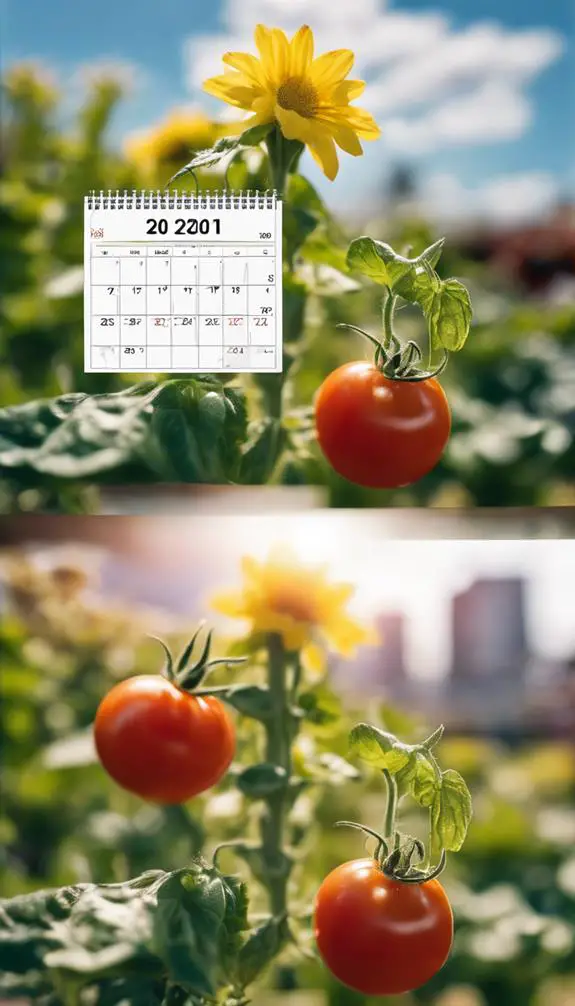
Before diving into the world of tomato planting, you'll need to pinpoint the ideal time to get started.
In most regions, it's crucial to wait until the last frost date has passed, as tomatoes are sensitive to frost. Check the average frost dates for your climate zone to determine when it's safe to plant.
In warmer climates, you can start planting as early as late winter, while in cooler climates, you may need to wait until late spring. Make sure to also consider the specific variety of tomato you're planting, as some are bred to mature more quickly than others.
Select a Sunny Location

Now that you've determined the ideal planting date, it's time to focus on where to plant your tomatoes.
You'll want to choose a location that receives direct sunlight for at least six hours a day, with morning sun being ideal.
Tomatoes need intense sunlight to produce well, so avoid shaded areas.
Consider the sunlight hours your yard receives and select a spot that gets the most sun.
If your yard receives full sun, you can plant your tomatoes in that area.
If not, try to find a spot that receives morning sun and partial shade in the afternoon.
This will help prevent scorching and promote healthy growth.
Space Tomatoes Correctly
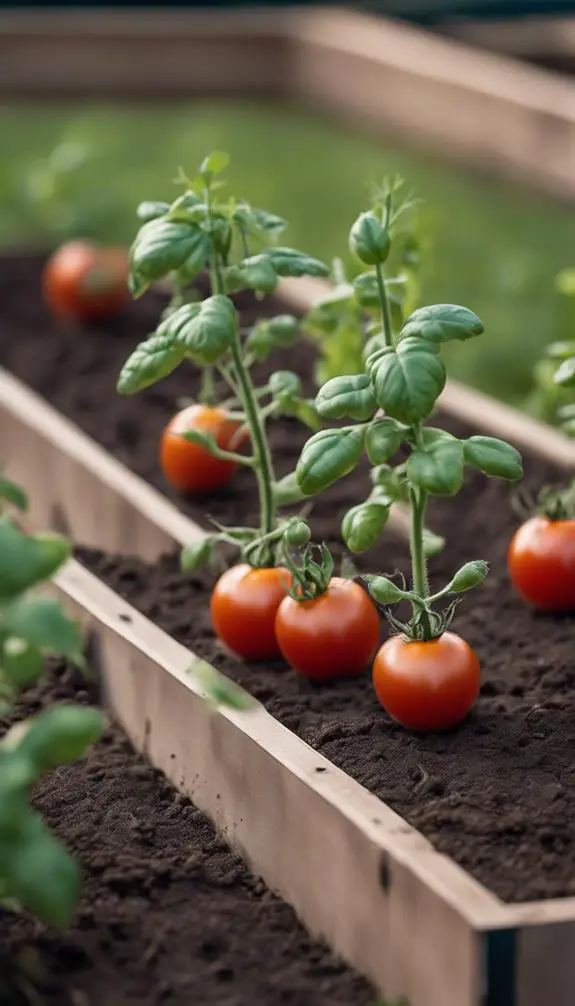
Determine the spacing for your tomatoes by considering the mature size of the variety you're growing. This will guarantee you provide enough room for air circulation, sunlight penetration, and easy access for harvesting and maintenance.
Typically, tomato rows should be spaced 2-3 feet apart, with individual plants spaced 18-36 inches apart, depending on the variety. Intercrop benefits can be achieved by planting smaller vegetables, like lettuce or herbs, between tomato rows.
This maximizes space utilization and promotes biodiversity. When spacing tomatoes, remember to leave enough room for support structures, like cages or trellises, which can take up additional space.
Proper spacing will result in healthier, more productive tomato plants.
Dig the Perfect Planting Hole
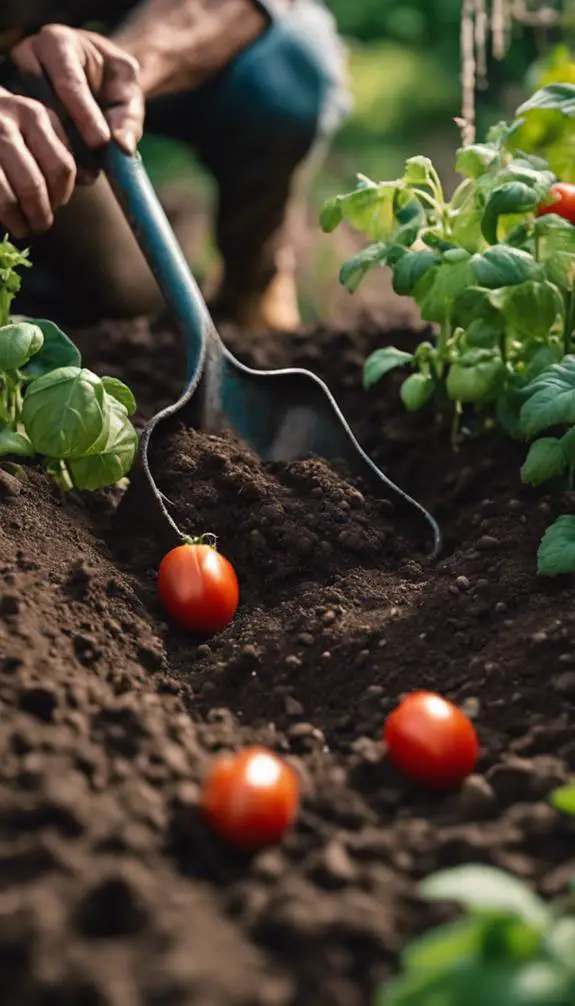
You'll want to make sure you're digging a hole that's the right depth for your tomato plant, as the roots need room to grow.
The type of soil you're working with is also vital, as tomatoes prefer well-draining soil with a pH between 6.0 and 6.8.
When digging, remember to space the holes correctly, leaving about 18-24 inches between each plant to allow for proper air circulation and sunlight penetration.
Hole Depth Matters
How deep should your tomato planting hole be?
When it comes to deep planting, the general rule of thumb is to dig a hole that's at least 12-18 inches deep.
This allows the tomato plant's roots to grow deeper into the soil, promoting healthy growth and development.
However, if you're planting a determinate variety, a shallower hole of 8-10 inches is sufficient.
When preparing the hole, loosen the soil at the bottom to encourage root growth.
Remove any debris and mix in some organic matter like compost to improve soil structure.
Soil Type Counts
With your tomato planting hole dug to the perfect depth, it's time to ponder the soil type that will cradle your plant's roots.
You want a well-balanced soil that provides the right environment for your tomatoes to thrive. Check your soil's pH level, as tomatoes prefer a slightly acidic to neutral soil pH, ranging from 6.0 to 7.0.
Soil density is also vital, as it affects water retention and aeration. Aim for a mix with a density that allows for good drainage and oxygen flow. Avoid heavy clay or sandy soils, opting for a loamy mix that retains moisture but drains excess water.
Space Correctly Please
Digging the perfect planting hole is crucial for giving your tomatoes the space they need to grow.
Avoid common tomato spacing mistakes by ensuring each hole is 18-24 inches deep and 2-3 times wider than the root ball of your tomato plant. This will allow the roots to spread out and absorb nutrients efficiently.
Consider your garden layout inspirations and plant tomatoes in a staggered formation to maximize space and air circulation. As you dig, loosen the soil to a depth of 12 inches to promote healthy root growth.
Add organic matter like compost or well-rotted manure to the hole to provide essential nutrients. With a well-planned planting hole, you'll be on your way to a thriving and productive tomato harvest.
Add Organic Matter to Soil
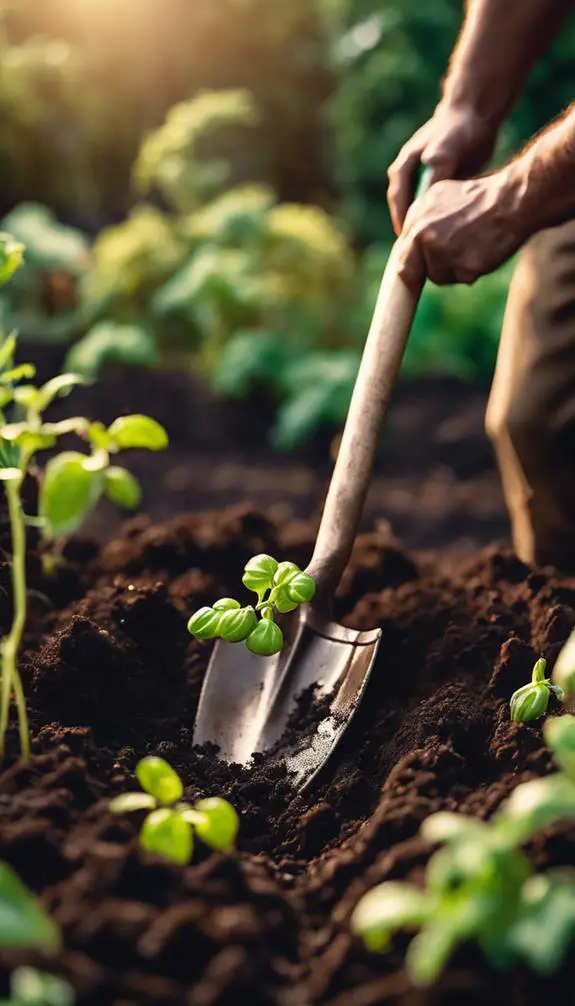
One of the most critical steps in preparing your soil for tomatoes is adding organic matter. This helps increase soil nutrients, creating a fertile ground for your tomatoes to thrive.
You can do this by mixing in compost, which has numerous benefits. Compost adds nutrients, improves soil structure, and increases the soil's water-holding capacity.
It also supports beneficial microorganisms, which break down organic matter and make nutrients available to your tomatoes. When choosing a compost, opt for one that's rich in nutrients and has a balanced carbon-to-nitrogen ratio.
Mix 2-4 inches of compost into the top 6-8 inches of soil before planting. This will give your tomatoes the best possible start, ensuring they receive the nutrients they need to grow strong and healthy.
Plant Tomatoes Deeply
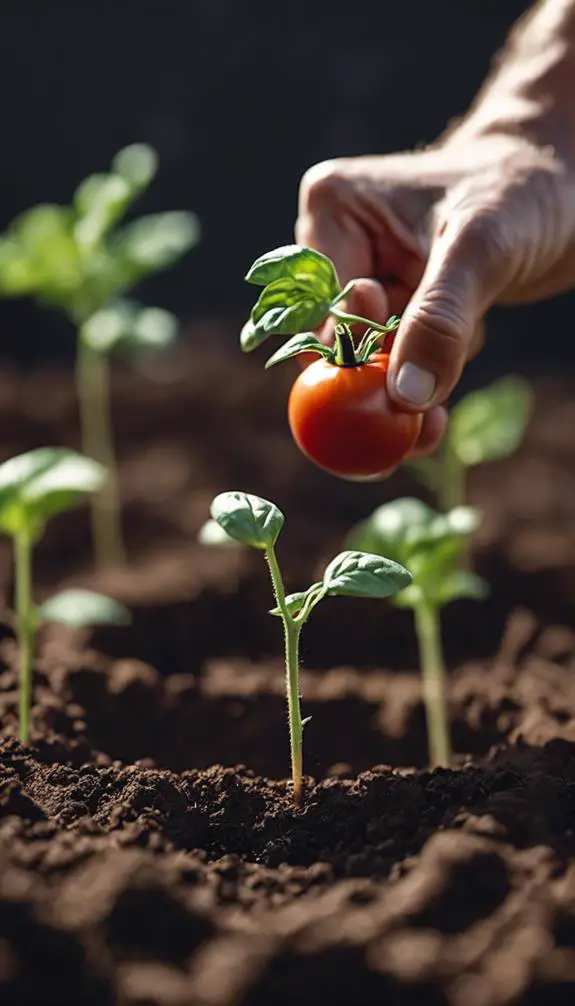
When you're ready to plant your tomatoes, don't just plop them into the ground – instead, plant them deeply to give them a strong foundation.
Deep planting allows the stem to develop more roots, leading to better root development. This, in turn, enables your tomato plants to absorb more nutrients and water from the soil.
As you plant, gently remove lower leaves, leaving only the top two or three sets. Then, place the plant in the hole, burying it up to the top leaves. This will encourage the stem to produce more roots, resulting in a stronger, more resilient plant.
Water Tomatoes Thoroughly

With the tomatoes planted deeply, it's vital to give them a good soaking to settle the soil and provide enough moisture to get them off to a strong start.
You'll want to use high-quality water that's free of contaminants and excess salts, which can impede soil absorption. Water your tomatoes slowly and thoroughly, making sure the soil is moist but not waterlogged.
Aim to provide about 1-2 inches of water per week, either from rainfall or irrigation. As you water, check the soil absorption by observing how quickly the water is absorbed. If the soil is slow to absorb, you may need to adjust your watering technique or add organic matter to improve soil structure.
Support Tomatoes as They Grow
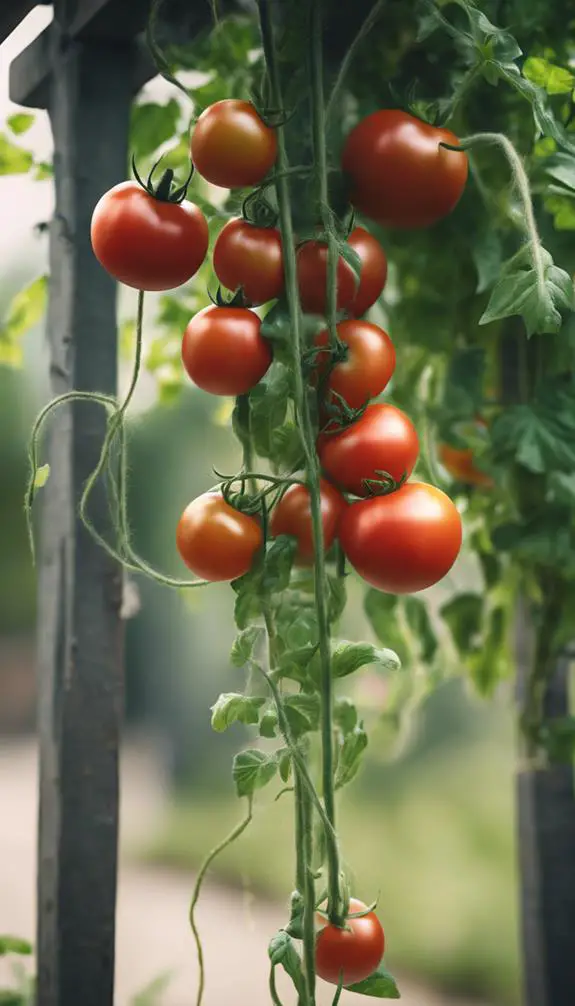
As your tomato plants begin to grow, they'll need support to keep them upright and encourage even fruiting.
You can use tomato cages or trellis systems to provide the necessary structure. Tomato cages are a simple and effective option, surrounding the plant with a circular framework that keeps it upright.
Trellis systems, on the other hand, offer more flexibility, allowing you to train the vines to grow upwards or outwards.
Both options will help keep your tomatoes off the ground, reducing disease risk and making harvesting easier.
Install your chosen support system at planting time to avoid damaging the roots later on.
With the right support, your tomato plants will thrive and produce a bountiful harvest.
Mulch Around the Plants
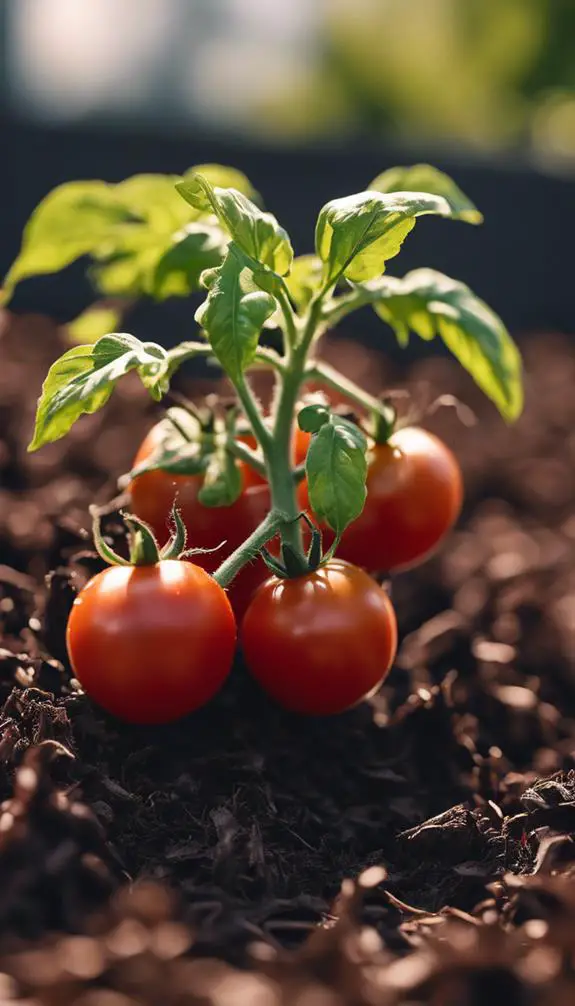
You'll want to mulch around your tomato plants to retain moisture, suppress weeds, and regulate soil temperature.
You have several mulch material options to choose from, including organic choices like straw, bark chips, or grass clippings, and inorganic options like landscape fabric or plastic sheeting.
Benefits of Mulch
Mulch around your tomato plants serves multiple purposes, including suppressing weeds that compete for water and nutrients.
By blocking weeds, you'll reduce the risk of disease transmission and minimize the need for herbicides. Mulch also helps regulate soil temperature, keeping it cooler in the summer and warmer in the spring.
This temperature control promotes healthy root growth and increases your tomato yield. Additionally, mulch improves moisture retention, reducing the need for frequent watering.
This not only saves you time but also reduces soil erosion and runoff. With mulch, you'll enjoy a more bountiful harvest with less maintenance.
Mulch Material Options
With your soil prepared and weeds under control, it's time to choose the right mulch material to surround your tomato plants.
You have several options to ponder. Bark chips are a popular choice as they're aesthetically pleasing, easy to spread, and break down slowly. They also help to retain moisture and suppress weeds.
Another option is straw layers, which are lightweight, easy to handle, and allow for good water penetration. Straw also breaks down quickly, adding organic matter to the soil.
Think about using a combination of both bark chips and straw layers for ideal results. Regardless of the material you choose, apply a 2-3 inch layer around your tomato plants, keeping it a few inches away from the stem to prevent rot.
Keep the Area Weed-Free
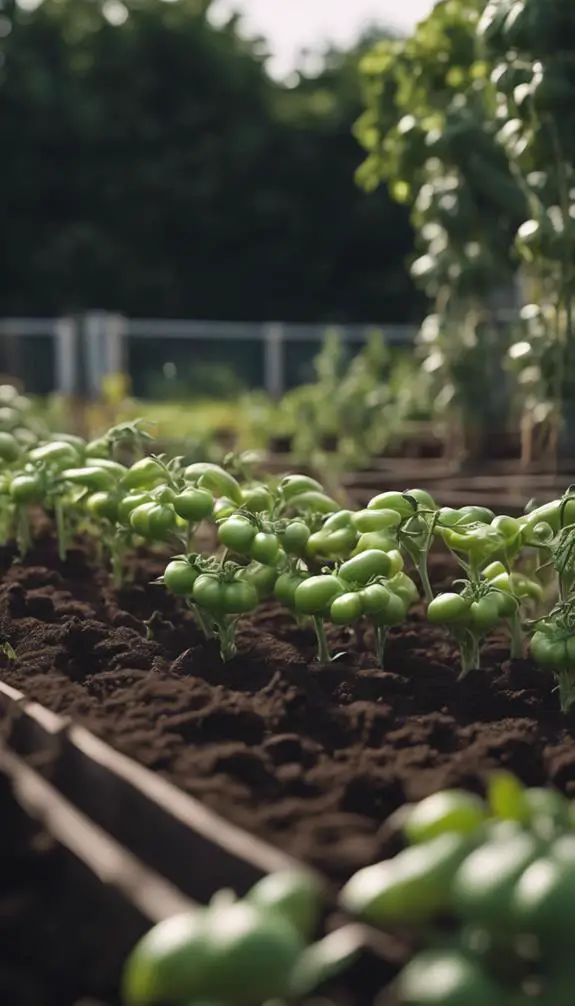
How can weeds compete with your precious tomato plants for water, nutrients, and sunlight if you don't let them?
To keep weeds at bay, lay down weed barriers or thick mulch layers around your tomato plants. This will prevent weeds from germinating and growing in the first place.
You can use landscape fabric, plastic sheeting, or organic mulch like straw or wood chips. Make sure to apply a thick enough layer to suppress weed growth.
Regularly check the area and remove any weeds that do manage to grow. This will guarantee your tomato plants get the resources they need to thrive.
FAQs
Can I Grow Tomatoes in Containers on My Apartment Balcony?
You can grow tomatoes in containers on your apartment balcony, but consider your balcony's layout and guarantee your containers are at least 5-gallon to provide enough room for root growth and adequate sunlight.
Will Tomato Plants Grow Well in Partial Shade?
You'll find tomato plants can thrive in partial shade, but they'll still need at least 4-6 hours of direct afternoon sun to produce well; their shade tolerance varies by variety, so choose one bred for partial shade for the best results.
Should I Remove Lower Leaves From Seedlings Before Planting?
When transplanting, you'll want to remove lower leaves from seedlings to prevent fungal diseases; this leaf pruning exposes the stem, allowing for better soil contact and a stronger root system, ultimately promoting healthy growth.
Can I Plant Tomatoes in the Same Spot Every Year?
When planning your garden, you'll want to avoid planting tomatoes in the same spot every year, as this can lead to soil depletion and decreased yields, making crop rotation a vital step in maintaining healthy, thriving tomato plants.
How Often Should I Fertilize My Tomato Plants?
You'll want to fertilize your tomato plants every 1-2 weeks, considering soil pH and choosing the right fertilizer type, like balanced or bloom-boosting, to guarantee maximum growth and fruit production, without overloading the soil with excess nutrients.
Conclusion
You've got the basics down, now it's time to get planting! Remember, a strong start sets the tone for a successful harvest. By choosing the right variety, prepping the soil, and providing the right conditions, you'll be on your way to juicy, delicious tomatoes. Don't forget to support and mulch your plants, and keep the area weed-free to prevent competition. With a little TLC, you'll be enjoying fresh tomatoes in no time!


